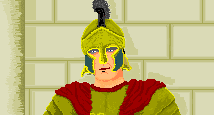
The Chronicles of Lucius
|
Page 2 Unit Stacking
|

FORM UP
|
Page
5 Detach
|


Lucius Art By Dean Beecham
Prime Centurion Lucius turned to face his optio and gave that knowing smile. A smile born of 5 years campaigning against Carthage. Lucius was not only smiling at the youth and innocence of these new recruits but at their ignorance of what was to face them. He knew better than most that training these recruits was not just about discipline but about formations and when to use them. If these recruits were to go beyond one battle they had to have drilled in to them how to change formation at the sound of the horn.
Lucius gave the command to his optio who marshalled the recruits in to some sort of line. Lucius slowly shook his head watching the confusion as the recruits tried to form up. He knew it was going to be a long day. His optio bellowed ‘Pay Attention’, and Lucius looked up at the new men of the Tenth Legion.
‘Today’, began Lucius, ‘I am going to explain the benefits of Formations. The reason why the Legion wins many battles is its ability to change formation to meet the change in conditions in the heat of battle’.
‘You are the infantry – the backbone of the Roman Army. You need to know when to form Line, Column, Wedge and Square’.
Optio Tiberius saw one of the recruits scuffing his sandals. Tiberius promptly moves over and stabs him with the butt of his gladius. ‘I told you to pay attention’, Tiberius snarled.
Lucius carried on –
‘Column – From breaking camp in the morning and making the day’s march, you are in Column, when moving to your position for battle you may need to move fast then you are in Column again. A Forced March is only done in Column. A Forced March has in the past resulted in stragglers, make sure you are not one of those for you may pay the penalty with your life. Never get caught by the enemy in Column. If contacted by an enemy force you are very restricted as to the number of men who can fight to the unit’s front.’
 in 2D :-
in 2D :- ![]()
‘Line – the standard battle formation, each man is expected to step from the second rank and fill any gap in the front rank and maintain a solid line at all times. This Line is the most flexible of formations. Movement is not slow and 20 men can fight in the front row of each unit. Remember your left side is shielded but not the right, try to keep your enemy on the left side.’
 in 2D :-
in 2D :- ![]()
‘Wedge – Few Barbarian units can survive an attack by the Wedge formation. One and a half times as many men can strike from the same space as a Line formation. But, in Wedge, your movement is slow and it is easy to be outflanked by enemy cavalry. The Wedge is also impossible to use on the charge without loosing formation and cohesion.’
 in 2D :-
in 2D :- ![]()
‘Square – This formation should be a last resort. Although all sides have shield protection, the square moves very slowly and only one quarter of the men can face in one direction for combat or firing.’
‘Now to recognise the signals for each formation. The Cornicen will blow the horn to show you which sound is used to signal which formation. First the Column …..’
The heat of the sun was already parching lips and Lucius could feel the dust in his throat. Better get these recruits in to shape soon, he thought, for the Carthaginian’s were reported to be assembling in Iberia for another War.
To Lucius’ right he saw a similar scene was being played out by a tribune from the Scipio family. The tribune was directing the new men of a cavalry turma practising the formations of the Roman horsemen.
First Lucius saw the turma form up in three decurie (three lines) one behind the other and practice the charge with spear in hand. The Roman Army only made the charge when its cavalry were in Line formation to maximise the impact.
 in 2D :-
in 2D :- ![]()
After the charge they quickly regrouped in to the Column formation for rapid movement back to their start position. Just like the infantry, the Column formation was reserved for when the army was on the march or rapid movement across the battlefield where contact with the enemy was unlikely.
 in 2D :-
in 2D :- ![]()
Finally, the cavalry demonstrated the Wedge formation. A very effective formation when clashing with enemy heavy cavalry. The Wedge is a difficult formation to maintain by the best of drilled troops and only the regular armies showed much use of this formation. Although slower than the Line, Roman cavalry could still achieve a charge in the Wedge formation.
 in 2D :-
in 2D :- ![]()
Lucius scanned the training ground of the Roman camp but could not find any sight of the allied Light Cavalry attached to the Legion. They must have been sent on a scouting mission. The Light Cavalry trained by the Roman Army also practised the Cantabrian circle. A formation first seen in Iberia. This was a circle of horsemen each throwing his javelin as he came closest to the enemy. The tactic was fine against enemy heavy infantry but of little use against equally mobile enemy cavalry.
 in 2D :-
in 2D :- ![]()